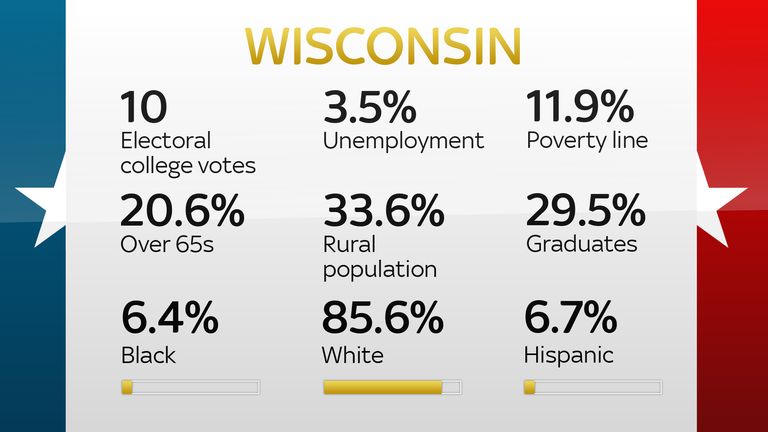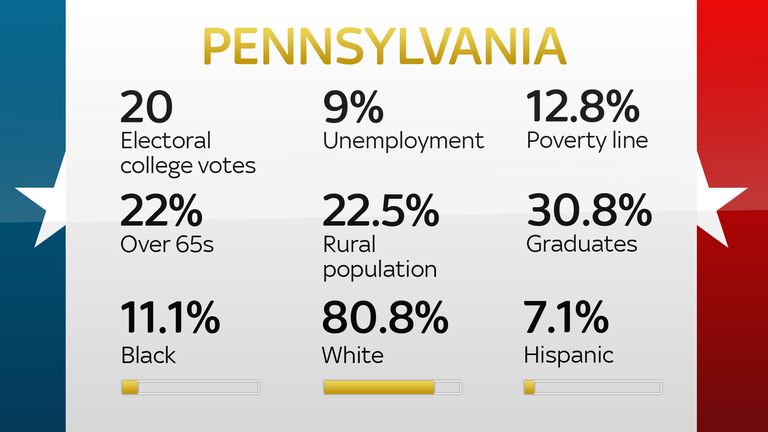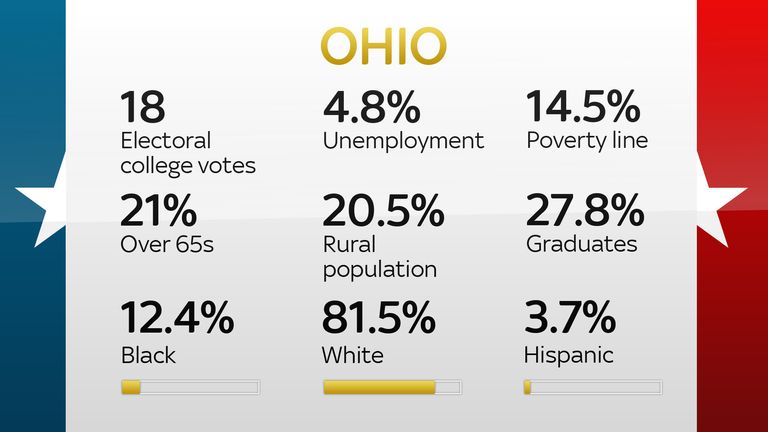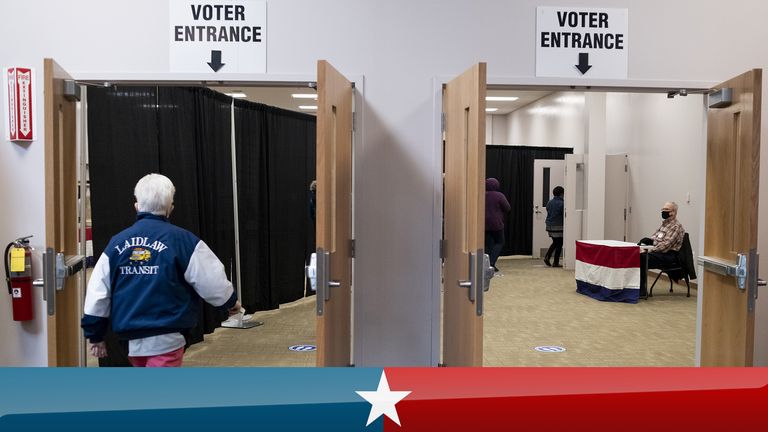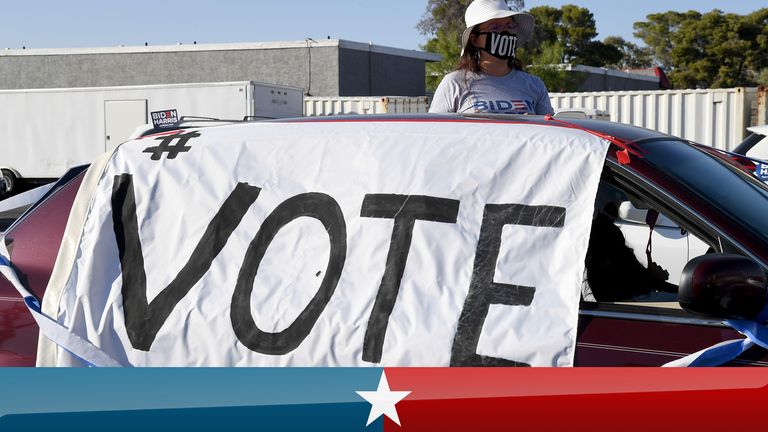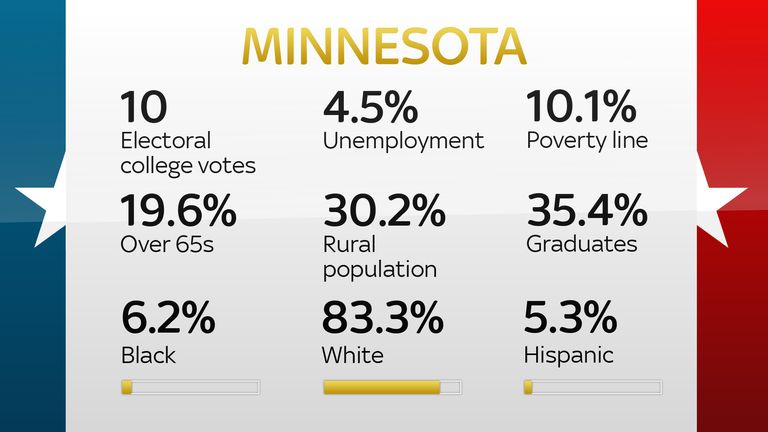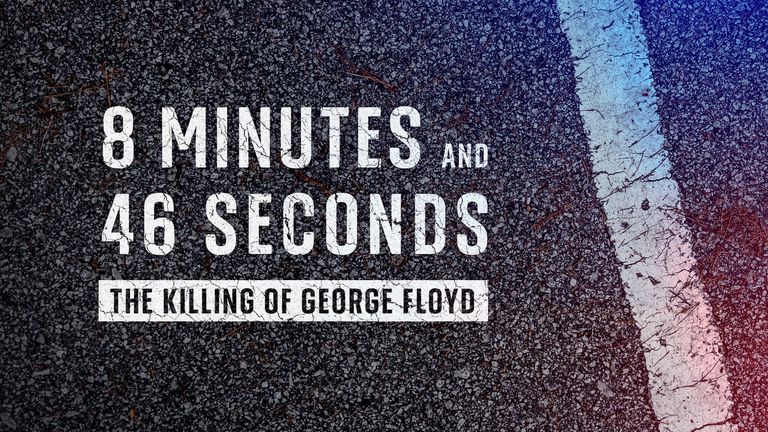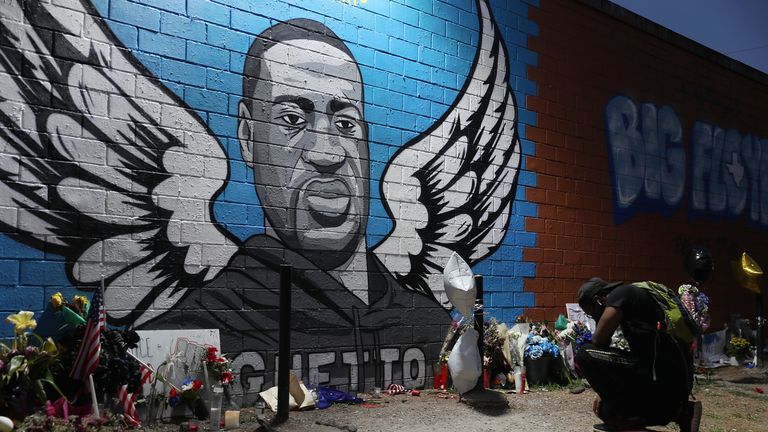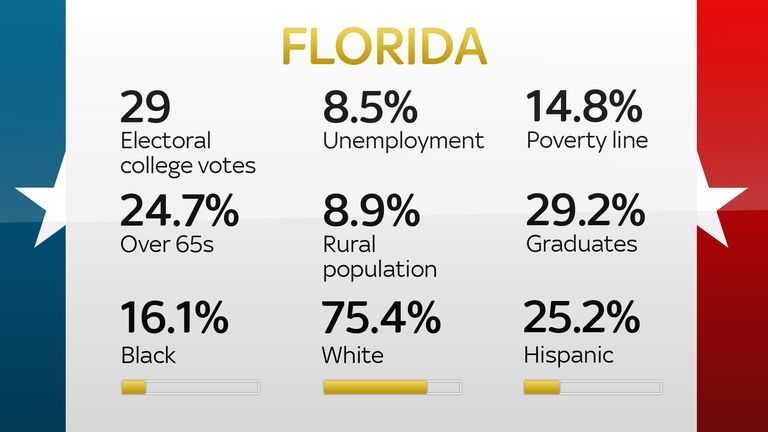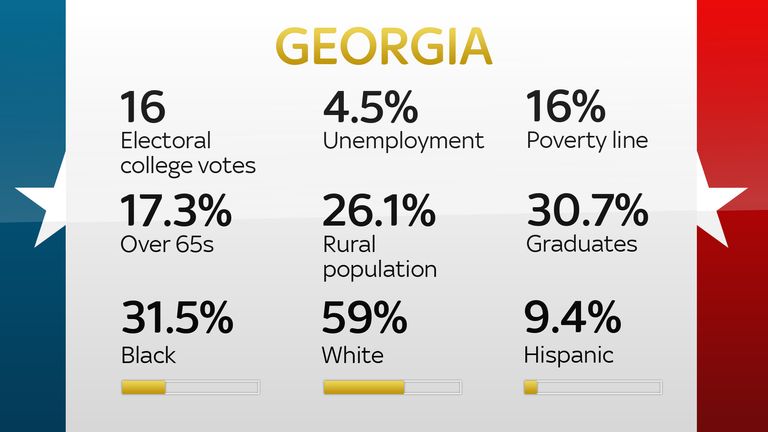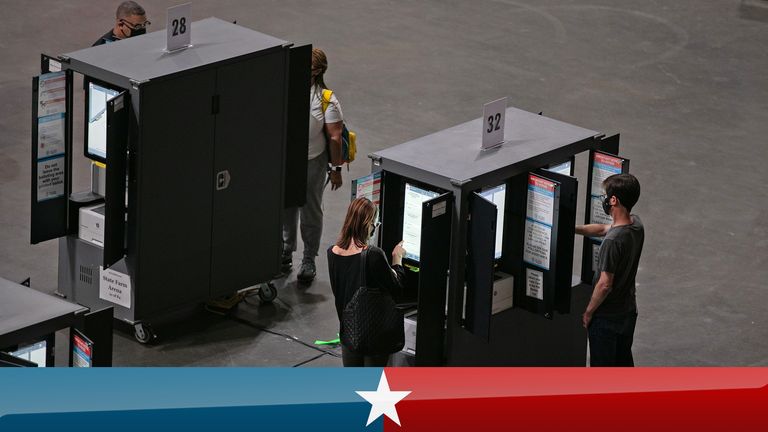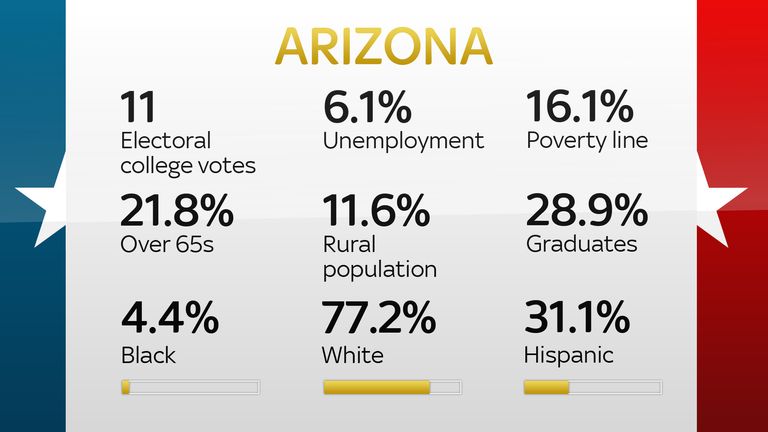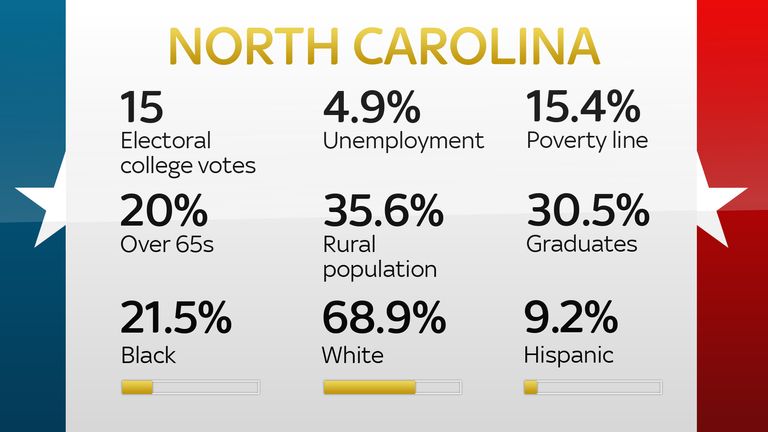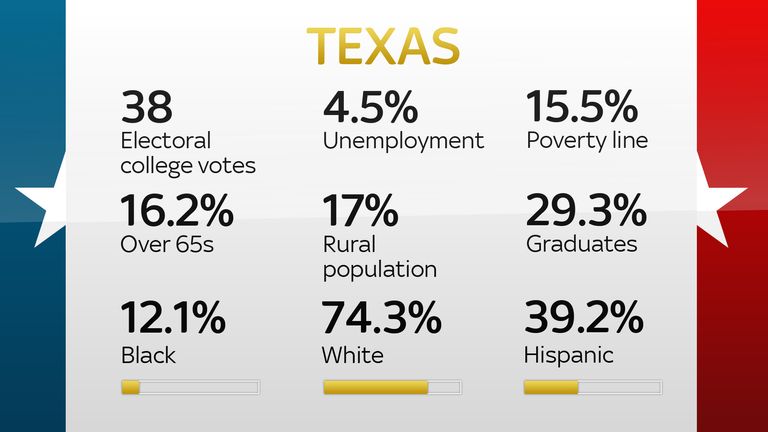US Election 2020: The swing states where the race to the White House will be won and lost
The US presidential election on 3 November will be decided, as always, by the “swing states”.
Donald Trump’s surprise victory in 2016 happened because he won Michigan, Ohio, Pennsylvania and Wisconsin from the Democrats.
Joe Biden’s chances of un-seating the incumbent, something that happens rarely in US elections – the last occasion being Bill Clinton’s defeat of George Bush in 1992 – require him reversing these losses.
At the same time he must avoid losing any states of his own, including Nevada and Minnesota.
But if the electoral mood turns against Mr Trump the Democrats could threaten Republican states, including Arizona, Florida, Georgia and North Carolina.
Should the Democrats win in Texas, however, not even Donald Trump would argue the election was rigged.
Mr Trump currently trails Biden in the national polls but this does not rule out his re-election. Hillary Clinton received almost three million more votes nationally than Mr Trump but still lost.
The national vote does not determine who sits in the White House. It is the 538 members of the Electoral College who do this. The winner needs 270 votes in the college to become president.
Each state is allocated college voters according to its population.
The smallest states each have three members. The largest states, California and Texas, have 55 and 38 members respectively.
Most states have a “winner takes all” rule, meaning the candidate winning most votes receives all its college votes.
Mr Trump won in 2016 because his votes were better distributed than Mrs Clinton’s. He won most votes in 30 states compared with Mrs Clinton’s 20, giving him 304 college votes.
The Democrats must learn from mistakes made in 2016. Mrs Clinton’s campaign under-estimated Republican support among struggling blue-collar workers in Michigan, Pennsylvania and Wisconsin (the so-called Blue Wall) all of which had been in Democrat hands since at least the 1990s.
Mr Trump’s margin of victory in each of these three states was under one percentage point but crucially delivered him 46 college votes – 15% of his final total.
What happens after the polls close is different in the US. While we wait for constituency declarations in the US votes are counted in over three thousand counties.
Regular reports of voting patterns are released throughout the night, enabling media organisations to keep a close eye on proceedings.
When sufficient votes have been declared the main broadcasters will “call” a state for either the Republican or Democrat candidate, awarding them the state’s college votes. It is often weeks after the election that the final voting figures become available.
Here we take a look at what each presidential candidate must do in the 12 swing states to win the White House:
The ‘Blue Wall’
Michigan (16 college votes)
Captured from the Republicans by Bill Clinton in 1992 the state looked secure for wife Hillary with the Democrats regularly polling over half the votes.
But with some former Democrats moving towards Mr Trump, the Republicans finished ahead.
It was not until a month after the election that the official result was finally declared with the Republican majority of just 10,704 votes.
Key to Mr Trump’s upset was his appeal to blue-collar workers who are normally strong Democrats but have suffered badly from the decline in manufacturing, particularly in Detroit.
Although a recent poll gave Mr Trump a one-point lead most forecasts favour Mr Biden to re-take the state.
Counties to watch: Kent, Macomb, Saginaw
Wisconsin (10)
Hillary Clinton never visited the state during her campaign, another of the Democrats’ strategic mistakes in 2016.
Just 22,748 votes gave Mr Trump victory here, the first Republican winner since Ronald Reagan in 1984.
The state has seen other cliff-hangers. George W Bush came close, losing by 6,000 votes in 2000 and 11,000 four years later.
Mr Biden should win if Democrat supporters can be persuaded to vote the party ticket this time.
Concentrating voters’ minds will be the rioting in Kenosha that followed the police shooting of Jacob Blake last August and the deployment of the National Guard.
Counties to watch: Kenosha; Racine, Winnebago, Brown
Pennsylvania (20)
Democrat controlled since Bill Clinton took it in 1992 the party lost out to Mr Trump by 44,000 votes in a turnout of more than six million voters.
In 2016 this was the tipping point which ensured Mr Trump would become the 45th president.
Although the cities of Philadelphia and Pittsburgh remained loyal to the Democrats, the Republicans won a majority in 56 of the state’s 67 counties.
Mr Trump benefited from some Democrats splitting their votes, returning a Democrat for the 17th Congressional District while backing Mr Trump for president.
Winning Pennsylvania meant he passed the important 270 college vote mark and for that reason the state is regarded as among the most important to watch for on election night.
Counties to watch: Berks, Northampton, Erie, Lancaster
Targets for Biden
Ohio (18)
Ohio is a bellwether state, reflecting the national mood as it moves between the two established parties.
It plumped for George W Bush in both 2000 and 2004, then favoured Barak Obama in the two subsequent elections before opting for Mr Trump last time.
No Republican has ever won the White House without winning Ohio. The Republicans won all but eight of the 88 counties in 2016 so the Democrats will not find it easy.
While Mr Biden leads in the national polls some surveys of Ohio’s voters show Mr Trump ahead there.
Most pundits believe Ohio remains too close to call. Should the state remain Republican but Mr Biden becomes president, it will signal the end of Ohio’s 66-year record.
Counties to watch: Montgomery, Lake, Delaware, Stark.
Iowa (6)
Mr Trump’s victory here was emphatic, beating Mrs Clinton by a margin of ten percentage points.
This was the worst performance for a Democratic party candidate since 1980.
Before Mr Trump’s win it had been held by the Democrats since 1988 apart from George W Bush’s narrow victory in 2004.
The Republicans won a majority in all but six of the state’s 99 counties in 2016. State-wide polling, however, suggests a narrowing Republican lead but current expectations are that Mr Biden will not win here.
Counties to watch: Dubuque, Scott, Black Hawk.
If Biden wins back these target states then he’s home and dry, unless the Democrats lose some states they already have.
The Republican campaign has talked up its chances in areas they feel are moving in their direction.
Where could Trump spring more surprises?
Nevada (6)
Mr Trump came within 27,000 votes of winning Nevada.
Before him, no Republican candidate since William Taft in 1908 had failed to win the state on their way to the White House.
Nevada has a knack of siding with the winning side, a record that goes back to 1976.
Although the Republicans easily win the state’s rural counties, mostly with large majorities, Democrat strength lies in just two counties – Washoe centred on Reno and Clark which covers Las Vegas – those accounted for more than two-thirds of all votes cast in 2016.
The Republican campaign must appeal to urban voters in these counties, many of whom work in the tourist and hospitality industries badly affected by the COVID-19 epidemic.
Current polling evidence suggests that effort is not working with Mr Trump currently given only a small chance of victory.
Counties to watch: Clark, Washoe
Minnesota (10)
Although the Democrats have won here since 1976 Mr Trump was less than two percentage points from causing an upset in 2016.
Before then, Republican candidates have only won three times since the war – twice supporting General Eisenhower in the 1950s and Richard Nixon in 1972.
Ronald Reagan would have won every state in his 1984 landslide were it not for Minnesota sticking with the Democrats, albeit by fewer than 4,000 votes.
About six in 10 voters are crowded into the Minneapolis-St Paul area which favours the Democrats with the remainder widely scattered across Republican-leaning small towns and rural areas.
In 2016 one in ten voters supported smaller parties or independent candidates.
The killing of George Floyd, a Black man from Minneapolis by a white police officer last May, guarantees that race relations will be a key factor in the election.
Expect a high turnout here – 75% voted in 2016.
Counties to watch: Hennepin, Ramsey, St Louis.
‘Red’ states Biden must win over
Florida (29)
Florida, has seesawed between the parties and is critical given its large number of college votes, the third highest of any state.
The candidate winning Florida has become president in every election since 1992.
The contest in 2000 between George W Bush and Al Gore, was settled by the outcome in Florida. After weeks of recounts and an appeal to the Supreme Court, it was finally awarded to Mr Bush.
There was another close finish in 2016 with the two parties separated by a difference of one percentage point.
The key to Mr Trump’s victory proved to be his appeal among Cuban-American voters.
The state is seen by many commentators as the tipping point, winning Florida is likely to take the victor past 270 College votes.
Counties to watch: Duval, Monroe, Pinellas, St. Lucie
Georgia (16)
This has been in Republican hands for the past six elections but the Democrats have been steadily narrowing the gap.
In 2016 the vote split 51-46 in Mr Trump’s favour. It was one of only 11 states to show an increased share for the Democrats.
Georgia’s population has seen the fifth fastest growth, particularly around the suburbs surrounding Atlanta which has enhanced Democrat prospects.
The latest state polling suggests a close race with Mr Biden ahead on some projections, Mr Trump on others.
Counties to watch: Baldwin, Cobb, Gwinnet, Henry
Arizona (11)
The state has voted with the Republicans in all bar two elections held since the war.
Mr Trump’s margin of victory, however, was reduced after some voters favoured minor party candidates.
Arizona was one of the few states where Mrs Clinton improved on Barack Obama’s performance, suggesting changing demographics may be assisting the Democrat cause.
People of Hispanic origin, the state borders the Mexican border, account for almost a third of the population and the Democrats will be campaigning to get these registered in time for November’s vote.
There has also been an influx of electors with college degrees, a demographic that often supports the Democrats.
Counties to watch: La Paz, Maricopa, Yuma
Trump’s must-holds
North Carolina (15)
Mr Trump must surely carry the state if he has any prospect of being re-elected.
Mr Obama carried the state narrowly in 2008 but lost it four years later. It stayed loyal to the Republicans in 2016 who increased their majority.
Generally, the state has sided with the Republicans with Jimmy Carter’s win in 1976 a notable exception.
The results in 2016 show the Republican victory was based on capturing some counties that voted for Mr Obama.
While current polling shows a small lead for Mr Biden the state is too close to call.
Counties to watch: New Hanover, Robeson, Watauga
Texas (38)
Voters have supported Republican candidates at every election since 1980.
In his re-election, Ronald Reagan won two votes for every one cast for his Democrat opponent.
Only Bill Clinton in 1992 came within a chance of victory.
But Texas is changing, with a higher turnout among Hispanic voters becoming evident over recent elections.
The state also has one of the largest concentrations of African Americans and increasing participation by these voters will be crucial to the Democrat cause.
Mr Trump’s vote is also vulnerable to his falling ratings among white college graduates who have been moving into the state in increasing numbers.
Should Mr Biden pull off a famous victory here then it is likely that he could win a landslide in the national election.
Counties to watch: Denton, Collin, Tarrant
Source: Read Full Article


